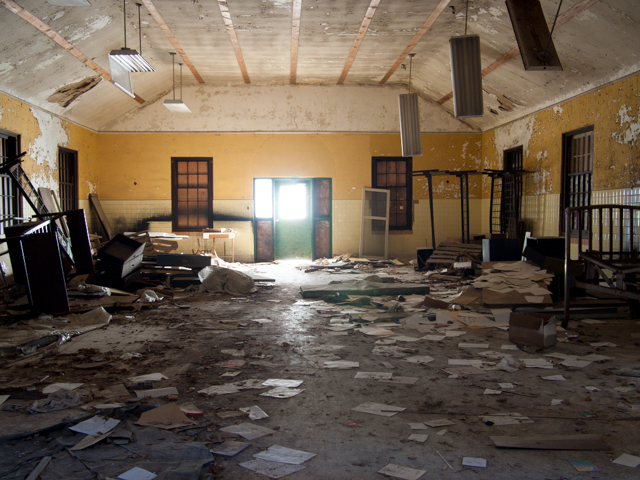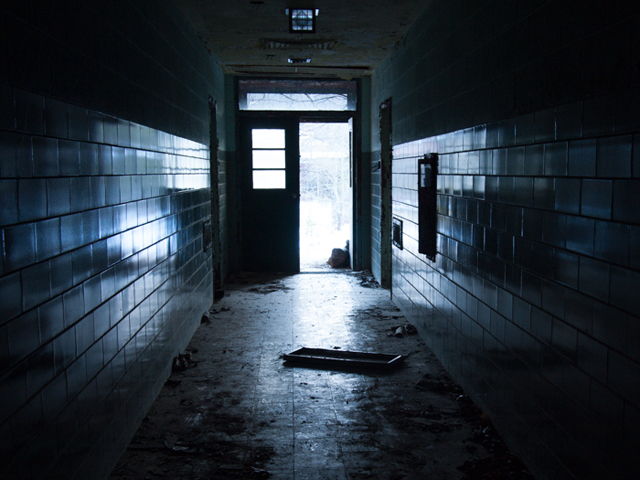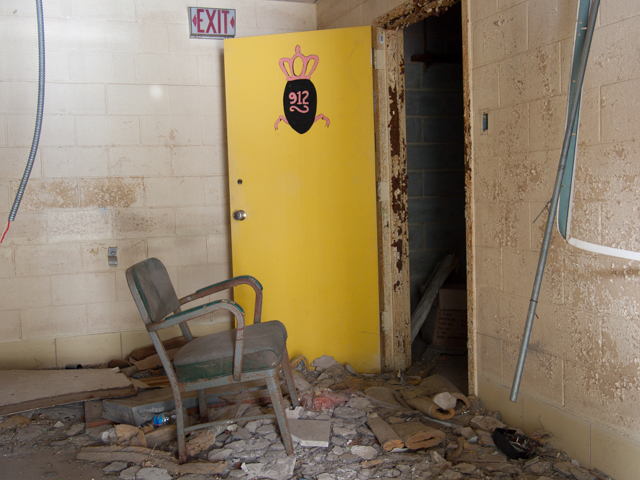Forest Haven Asylum is the most disturbing place I’ve ever visited. Maybe that’s why I felt compelled to return there repeatedly. Nothing could undo the human atrocities the asylum witnessed in its seven decades of existence. Maybe documenting their horrific legacy could show people how terribly wrong the ideology behind the asylum system really is.
After my friend and I had spent hours in the labyrinthine halls of the Curley building in this huge complex outside of Washington D.C., with its hundreds of adult cribs, bathtubs with arm restraints, and piles of canned foods and plastic urinals, our camera batteries gave up. Shooting in the dark is draining, and shooting what seemed like an endless sea of beds and hallways drained both our batteries and our psyches. We needed to get out of there.
It was our intention to leave the grounds and not go back. After our first day, our brains were already completed overloaded. By the first half of our second day, we had shorted out. We had walked into horrors we never expected, and we were left both empty and full.
But as we worked our way back through the snowy forest, I couldn’t help looking back at the old residential buildings. Their empty windows with ragged curtains blowing through broken glass beckoned me. It’s like they were waving to us: “Come Back!”. I could not shut out their cries, no matter how hard and fast I walked. Surely there were stories there, and I needed to tell them. The excavation or rather exhumation was well underway. We had become grave diggers, and we couldn’t stop the exhumation now.
We headed into the nearby town of Laurel, Maryland to find a place to charge our camera batteries. The best offering was a local working-class Target. We sat on the floor hunched in a pile of numb while we waited for the orange lights on our chargers to turn blue. Every minute, the sun sunk lower in the sky, and we were losing light. People came and went. Little girls with Barbies. Men with TVs and economy packs of toilet paper. None of them aware of the acres of human horror that resided just on the other side of the woods. Who knows what they thought of us. Two adults sitting on the floor, leaning against a wall and staring at the little LEDs on our chargers as if our life depended on it.
Maybe our life didn’t depend on it, but I felt all those lost lives at Forest Haven did. I needed to go back and get more evidence, share this secret sequestered away on the outskirts of the Federal government’s vast bureaucracy. As soon as the batteries had enough charge to make it through dusk, we packed up, bought a few energy bars and bottles of water at the Target to get us through the rest of the day, and sped back to the parking lot next to the trail.
We didn’t waste time. We walked in total silence, rapidly heading straight for the institution’s original dormitories. We felt like ghost hunters. Lone agents. Collectors of evidence. The first building was surrounded by an icy river. The door was locked, but I shoved a chair under a window and climbed inside. A stairway led up and down. We moved quickly through the main floor. It opened into a grand hall. Beds were stacked against the walls as the fading light made halos on the walls and floors. As if angels were hovering just outside the windows, because surely those who suffered here were angels.
At one point, this large room may have been intended for resident dances. Perhaps the founders envisioned banquets and parties. An old carved wooden fireplace dripped with icicles. No warmth here. With overcrowding and the need to cram more bodies into the space, function quickly superseded elegance. Beds clogged the floors. Bodies were strapped down rather than left free to waltz. Canned food was force-fed down reluctant throats, and hors d’oeuvres were something delivered through the static-filled broadcast of old movies on TV sets that could only pull in a few channels.
Fluorescent lights dangled tubeless from the ceiling. Amputated. Gutted. The light had long gone out. Paperwork littered the floors. While the beds rested against the walls like phantom bodies, patient records were scattered everywhere, the true evidence of how disposable these people were. Names bled into anonymous blurred ink after years of bad weather. Birthdates. Social security numbers. Diagnoses. All reduced to garbage just like the people they identified. No ceremony. No boundaries. No privacy. People were numbers and those numbers were being erased by history.
Small offices housed desks with drawers gaping open. Empty chairs were sad testaments to the people who sat listening to their sentence. Words recited by the intake staff were probably scribbled in manuals tucked in the bowels of drawers that flopped like open mouths. Mouths that spoke the standard bureaucratic language of the Human Disposal System. Language that fell on ears that couldn’t understand even if they were able to understand because there was nothing about this place that ever made human sense. It was necessary for people not to understand, because the inhumanity of Forest Haven was beyond comprehension.
What did they say to those who walked through the door with a single suitcase of belongings? “Welcome. You are now going to spend the rest of your life filed away like obsolete information in a storage facility. When your time is up, we will bury you on the grounds. You have forfeited all rights to identity, privacy and choice.” No wonder they closed the ballroom.
Sofas and chairs were scattered in various rooms. Waiting rooms because, for the lucky few who actually could sit in a chair or a sofa, this is a place where they waited. Waited for the end. Waited for someone to arrive to take them out of there. Waited for more waiting. Others had gurneys instead of sofas. They could be wheeled into common rooms and howl while the others waited and stared into the future they would never have.
There were artifacts of civility. Record players and radios. Music calms the restless soul. Perhaps the strains of Frank Sinatra beckoned them to a better place. Barbershop chairs sat waiting for the next customers who would never arrive. Looking good on the outside, can make you feel better on the inside especially when your whole life is spent inside, right? Some residents got haircuts and maybe even had their hair curled. All in preparation for the day that would never come. The special day when they would finally be freed from this prison.
But there was an out. An old art studio lies tucked away in a grove of trees. A desk covered with bottles of paint in every color is shoved next to an enlarger used either for photographs or dental records. Stacks and stacks of canvases are piled on top of each other and leaned against walls. They had been painted over and over again by residents. This place didn’t waste anything other than people. Portraits were layered on portraits upon portraits until all the faces became a singular blur. Evidence of letters and messages peeked out from under the layers of paint. Perhaps these were secret messages, like letters in a bottle. Help. Get me out of here.
The patients did get out of there. On Sundays they were wheeled and marched down the slope to the church. Stained glass windows streamed with colored light. Residents stretched the arms to the rays of red, blue and yellow as if they could touch God. As if God would save them. The asylum minister would give them a sermon about the good of God, and how they would someday find the light.
But the light didn’t come. It just got darker and darker. It got so dark that my friend and I could barely find our way out. Rooms were socked in shadow. Gurneys and mattresses leaned against walls and doors, turning the buildings into fortresses. Even the church went black.
In a room completely reduced to rubble, a lone telephone lay in a pile of crumbled asbestos. The receiver was torn off, the cord ripped from the wall. No a dial tone. No calls. This is the cut-off line. The end of the line. The point of no return.
We turned our back to the dark and inched our way through the ice in silence, trying not to fall in the dark. And even then, after all I’d witnessed, I started to feel that strange compulsion to return.
All photographs courtesy of the author. You can see more photos from her series on Forest Haven Asylum at her artist’s website.













